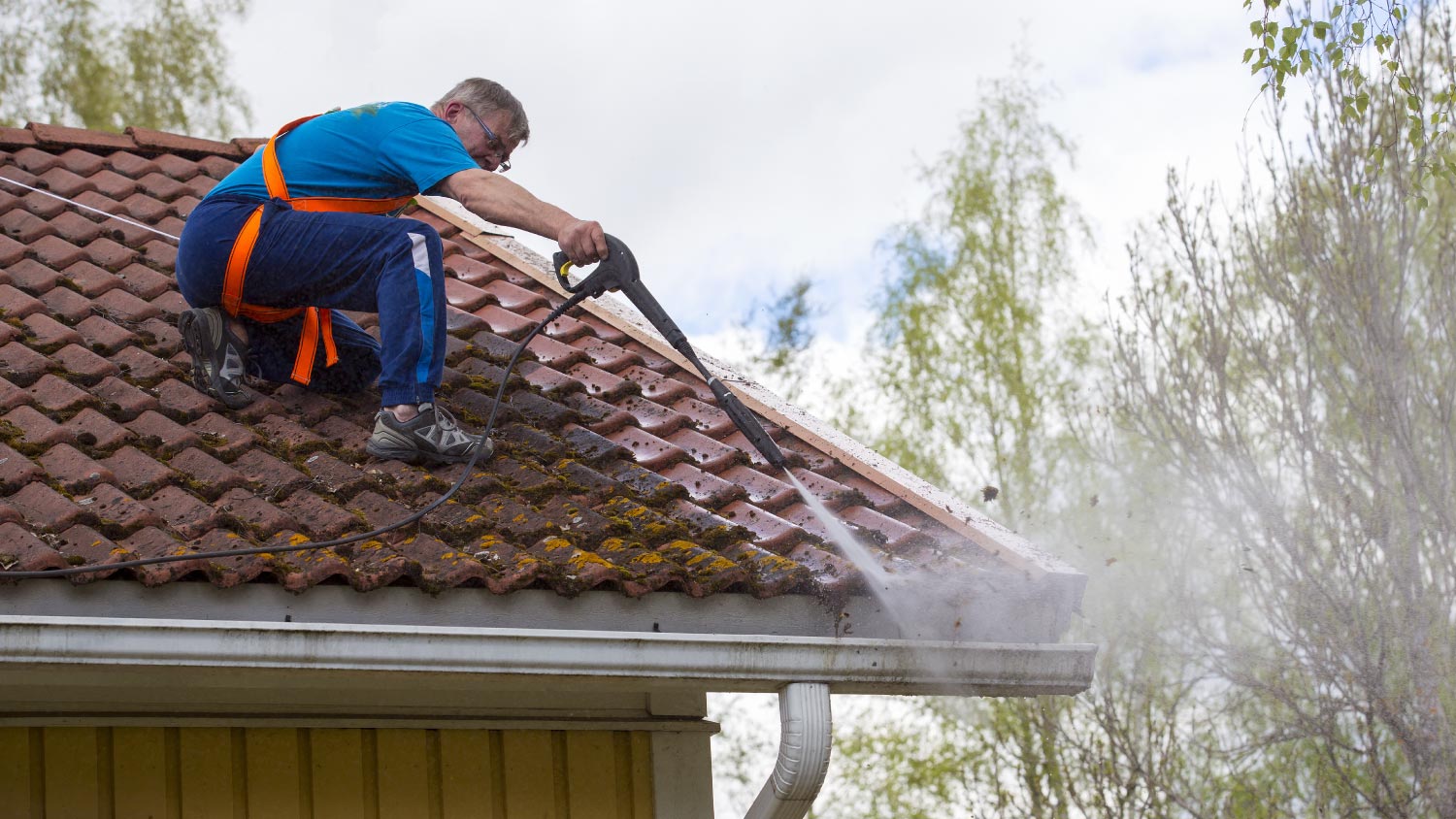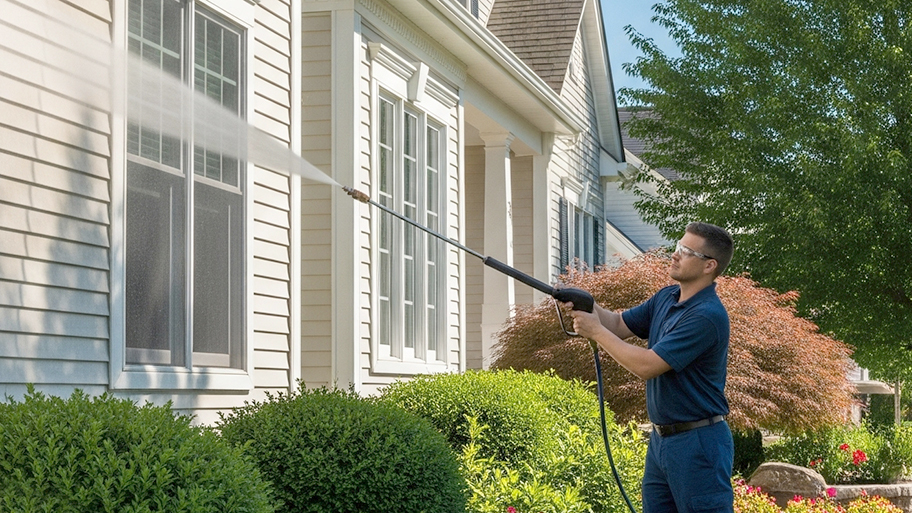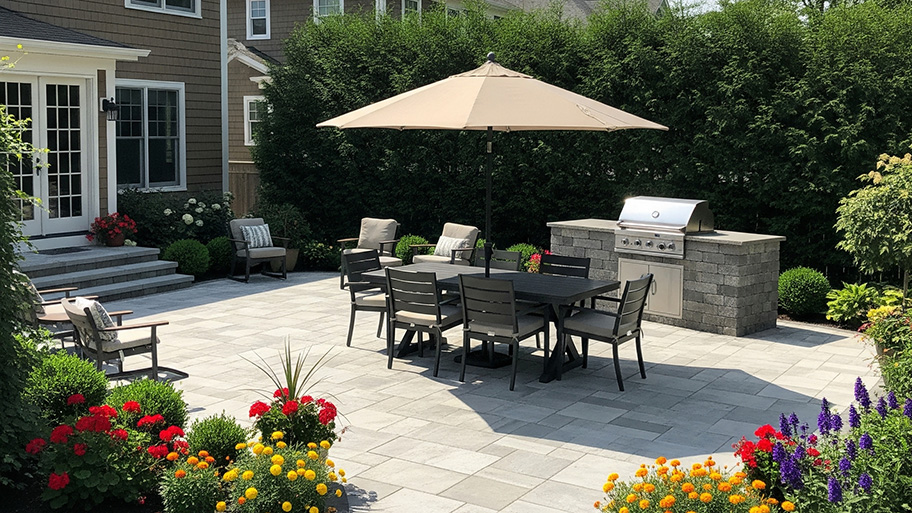
Pressure washing your fence can restore its appearance and keep your home looking great. Learn how much it costs based on factors like square footage and material.
Wash away any doubts about when to tackle this chore


Most homeowners can power wash their houses once per year.
Homes in areas with more air pollution should be power washed twice per year.
The best time of year to power wash a house is spring or fall.
Winter is the worst time to power wash because cold temps can damage the power washer.
Power washing a house costs $150 to $1,400.
Power washing the house is a big chore, and it’s easy to want to push it later and later on your calendar. You may wonder how often you should power wash your house or how long you can put it off between washings. Don’t delay this task on your to-do list too long, otherwise the dirt buildup could actually cause damage to your siding. Instead, here’s what to know about how often to power wash your house and the best time of year to tackle this chore.
You should power wash your house once per year to boost your curb appeal and extend the life of your siding. However, if you live somewhere with higher pollution levels or with a lot of precipitation, power wash your house twice per year. How often you power wash your house also depends on the exterior material because there are some materials you should never pressure wash or power wash, like brick.
The best time to power wash your house is in the spring (March through June) or early fall, when temperatures are not too hot or too cold.
| Season | Pros | Cons |
|---|---|---|
| Spring | Mild temperatures, less risk of mold or mildew growth | Rainy weather |
| Summer | Warm, sunny weather | High demand for pros and rentals, higher prices |
| Fall | Mild temperatures, lower demand | Rainy weather, leaf debris |
| Winter | Little demand, low prices | Cold temperatures can damage the power washer, uncomfortable to power wash in the cold |
Choose a day when temperatures are between 40 and 75 degrees Fahrenheit for your comfort and to keep the machine running smoothly. Try to power wash on a dry day so that any precipitation doesn’t interfere with your cleaning.
While summer’s sunny weather and warm temperatures are great for power washing, all your neighbors will probably be power washing around that time, too. That can make it harder to book a power washer rental or hire a pro, and costs could be higher during peak demand.
Pressure washing can be dangerous and damage your property if not done correctly. We highly recommend hiring a pro to ensure the job is completed safely and correctly.

Knowing when and how often you should power wash your house depends on several factors, from the weather to the type of siding you have.
Some materials, like composite siding or metal, are durable enough to withstand more frequent power washings twice per year. Vinyl siding does well with power washing once per year.
There are some materials you should never power wash, especially brick and masonry. These materials can crumble or loosen if you power wash them. Similarly, using a power washer on wood can strip it of any sealant or stain and cause it to split or warp. Add a pressure gauge to your power washer to make sure you’re using the right amount of pressure for the job at hand.
When temperatures are too low, the water could freeze and damage the power washer. If temperatures are too high, it could be uncomfortable to work in waterproof rain gear, gloves, and other protective equipment.
Power washing a house while it’s raining, sleeting, or snowing can reverse all of your hard work, so you won’t get to see that oh-so-satisfying power washing before and after. As you move the power washer wand along the house to remove grime, the precipitation will leave behind streaks of dirt. Wait for a dry day to power wash your house.
If you live somewhere that gets a lot of air pollution, you may find yourself needing to power wash the house more often. Air pollution can cause more grime to collect on your siding, and it’s important to wash it off at least a couple of times per year to extend the life span of your home’s siding.
You’ve selected a beautiful spring or fall day to power wash your house, but at what time should you power up the machine? Start earlier in the day so that the midday sunshine has enough time to help dry the siding and any other parts of the house you power wash. If you start late, the moisture could remain on the siding for longer, and that could leave water spots behind and encourage mold or mildew growth.
The worst time to power wash a house is in the winter for several reasons. For one, you’ll power wash the house only to have it battered by rain and snow, which is sure to leave streaky dirt and debris behind throughout the season. Not to mention, it can be pretty uncomfortable fumbling with a power washer when your hands are shaking from the cold.
Another issue with winter power washing is freezing temps. Using a power washer when the temperature dips below 32 degrees Fahrenheit means that the water could freeze, causing issues with the machine or leaving your house covered in frost.

Power washing a house costs an average of $150 to $1,400, depending on the size of the house, the number of stories, the material of the siding, and whether you DIY or hire a pro to finish the job. For larger or multi-story homes, the cost may reach $1,800 or more.
You can DIY pressure or power washing if you have the right equipment and take the necessary precautions to avoid damaging your siding. Handling this job could save you around $50 to $150 per hour in labor costs, but if you don’t already have a power washer or PPE, the cost could add up to around $140 to $1,450 or more.
| Required DIY Supplies | Average Cost |
|---|---|
| New power washer | $100–$1,000 |
| Power washer rental | $35–$175 per day |
| Goggles | $5–$40 |
| Respirator | $30–$50 |
| Gloves | $10–$30 |
| Non-slip waterproof boots | $25–$150 |
| Rain suit | $20–$100 |
| Tarps | $5–$30 each |
| Power washer detergent | $10–$20 per bottle |
If you don’t want to buy all the equipment to power wash your house or you’re worried about ruining your siding, skip the DIY and leave this job to a power washing pro near you. If you make a mistake, you could spend hundreds or thousands of dollars on siding repairs, but a pro will know how to get your home looking fresh and clean without causing any damage.
From average costs to expert advice, get all the answers you need to get your job done.

Pressure washing your fence can restore its appearance and keep your home looking great. Learn how much it costs based on factors like square footage and material.

Need to breathe new life into your dirty siding and trim? Explore the cost to pressure wash a house to boost your curb appeal instantly.

The cost to pressure wash a patio depends on the size of the surface and the type of patio you have, as well as whether you DIY or hire a pressure washing pro.

Does your pressure washer lack pressure? Or will it not start at all? Know who repairs power washers and who to call to get yours fixed.

Considering DIY pressure washing your home instead of hiring a pro? We’ll help you weigh the pros and cons of each option.
Pressure washers have many uses from cleaning patios to scrubbing cars. This guide covers the most common pressure washer uses to help you make the most of this tool.